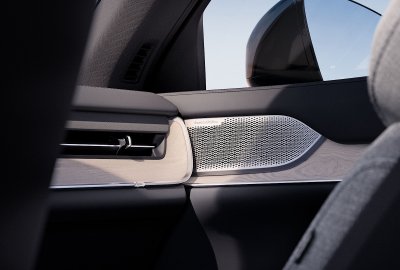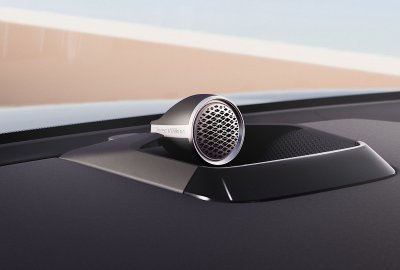The Sound Of a New Volvo Is Silence

As Simon & Garfunkel found out in 1965, there’s something Americans truly appreciate about the sound of silence. In electric cars, silence, like time, is a luxury.
As new electric vehicles (EVs) come to market, automakers are looking to put their stamp on what it means to drive an EV. For some, this means making the car into an amusement device, installing sounds linked with human body functions. To others, it means something else entirely.
Tesla’s flatulence feature debuted as an Easter egg in 2018 and continues to be available today. The seven-noise option is able to perform the sound of a gas emission from the posterior on command, or during a preset function, like using the turn signal. Now, the sound can be heard outside the car in addition to inside.
Hyundai has taken a more traditional route with the Ioniq 5 N. Its N Active Sound + technology works in harmony with the car’s faux shifting technology, N E-shift, to deliver an electrified version of a traditional powertrain setup sound and feel.
While N E-Shift simulates the feel and actions of an eight-speed dual-clutch transmission, N Active Sound + delivers synchronized audible cues.]
Mercedes-Benz
The Mercedes-Benz G 580, the company’s new all-electric G-Wagen, takes a completely different tack, offering a G-Roar soundtrack to buyers. Deep bass and sonorous tones can be selected in a variety of modes. “Comfort” is a more restrained sound experience while “Sport” is more powerful and emotional.
Additionally, the vehicle’s soundtrack has an “aura” sound that can be heard around the vehicle when it is parked, as a driver approaches, and upon opening the door once a journey is complete, until it is locked.
Volvo is skipping electric vehicle digital sounds, instead opting to create a serene cabin experience aside from alerts and chimes that directly impact driving and riding conditions. Riding in the new EX90 SUV allows drivers to concentrate on their travel without the noise of excess sound.
“When we think about sounds, we want to do it. But, it’s purposeful, it’s meaningful. It’s adding to the experience and not just gimmicky,” Thomas Stovicek, Head of UX at Volvo Cars, told Newsweek during a media roundtable in Sweden at the company’s design headquarters.
“From the experience standpoint, with what’s different in cars than like mobile phones or things, it’s much more of a multi modal experience. You have haptics, you have the feel of the buttons, you have the visual of the screens, you have sound, you have voice control, and our team is looking at how all of those things interplay,” he said.

Volvo Cars

Volvo Cars
But, that interplay needs to be purposeful and correctly timed, Stovicek warned. “With a lot more of the safety systems and a lot more sensors in the car, you can alert the user a lot. But, we need to think about how to do that in a reasonable way; so that it’s reasonable, and it’s understandable.”
Sound supported by visuals leads to better user understanding, Stovicek believes, and it is linked to a richer behind-the-wheel experience when those sounds are purposefully integrated.
“We have a sound design team that’s redesigning or rethinking like the character of the sounds, and how does an alert sound differently in different contexts? And what is the purpose of the sound,” he posited.
Developing new types of sounds goes beyond refining dings and tones. It also involves evolving the intentionality behind their use.
“Some of the sensor sounds that we had in previous cars, where it was very digital experience … when you’re backing up and those kinds of things sounded very much like an alert, like there was a problem. Backing up is a very standard process, it’s not a problem if you just don’t want to hit anything behind you. Can we soften that sound in a different way and make it more of a mayday. I mean, you’re going to backup so can we make the sound more of a guiding sound rather than an alert? And so how do we think about the purpose of the sound and what it’s doing,” Stovicek said.
Volvo has a team of sound engineers working to develop the sounds of its new EX90 battery-electric SUV. Stovicek keenly pointed out that many of them are musicians in their off time, saying that because of this, “they understand different sounds, instruments, candences [and the] leveling of sound, like how bass and treble play together.”

Volvo Cars

Volvo Cars
But, developing a car’s sound, or lack thereof, goes deeper. “They really think about all of these things and how they played to character and emotion and psychology, psychological understanding of the sounds. If we go back to the alert, if you start hearing alert sounds, you automatically tense up, you add stress to an already potentially stressful situation if you’re in an emergency, like parking lot, situation.
“Can the sound be a little bit more soothing and more guiding? I think that plays into the premiumness. How do you craft that sound to be appropriate? How do you make people feel like it’s helpful and not just an alert? Those are, I think, are elements that make [EX90] more premium.”
Uncommon Knowledge
Newsweek is committed to challenging conventional wisdom and finding connections in the search for common ground.
Newsweek is committed to challenging conventional wisdom and finding connections in the search for common ground.



